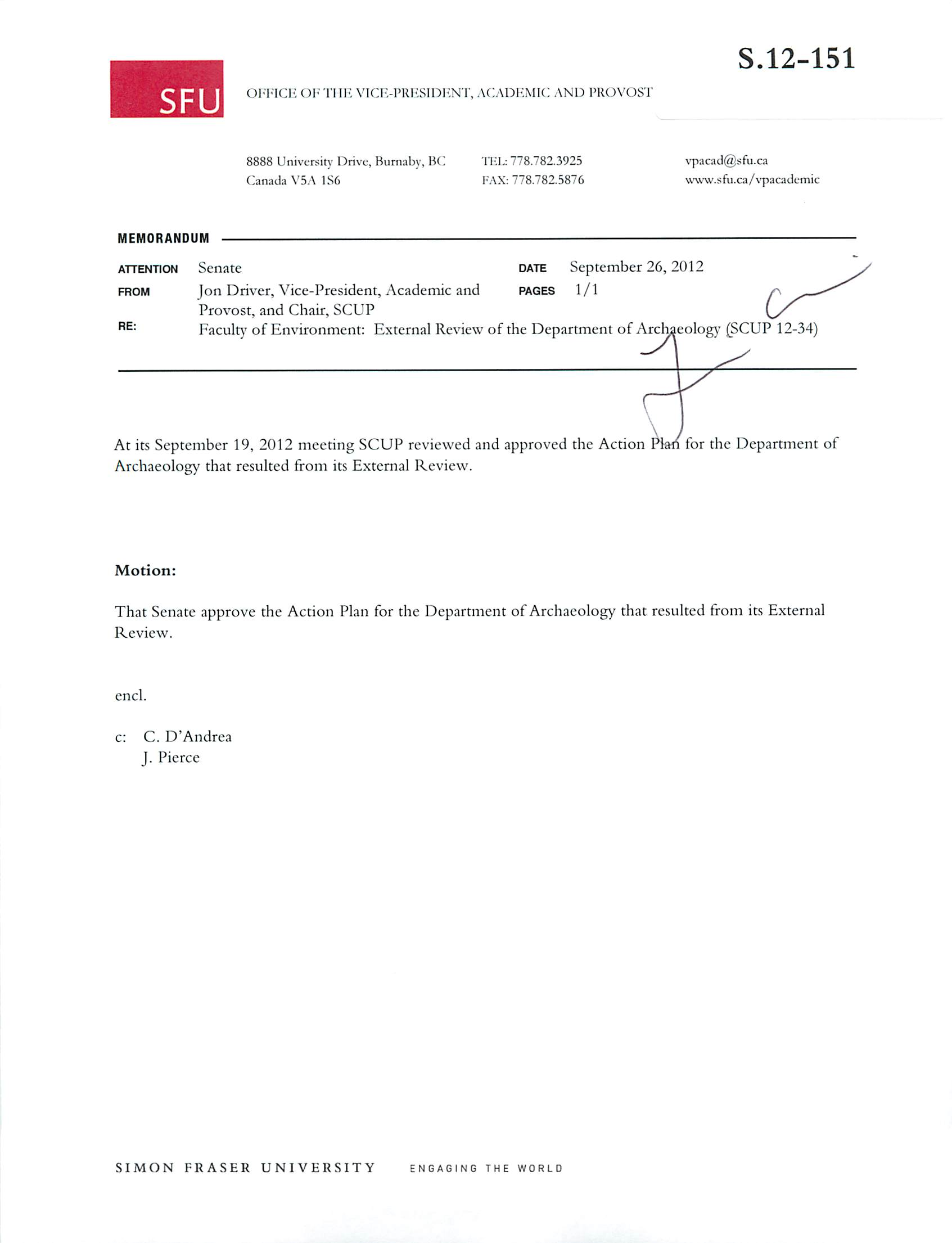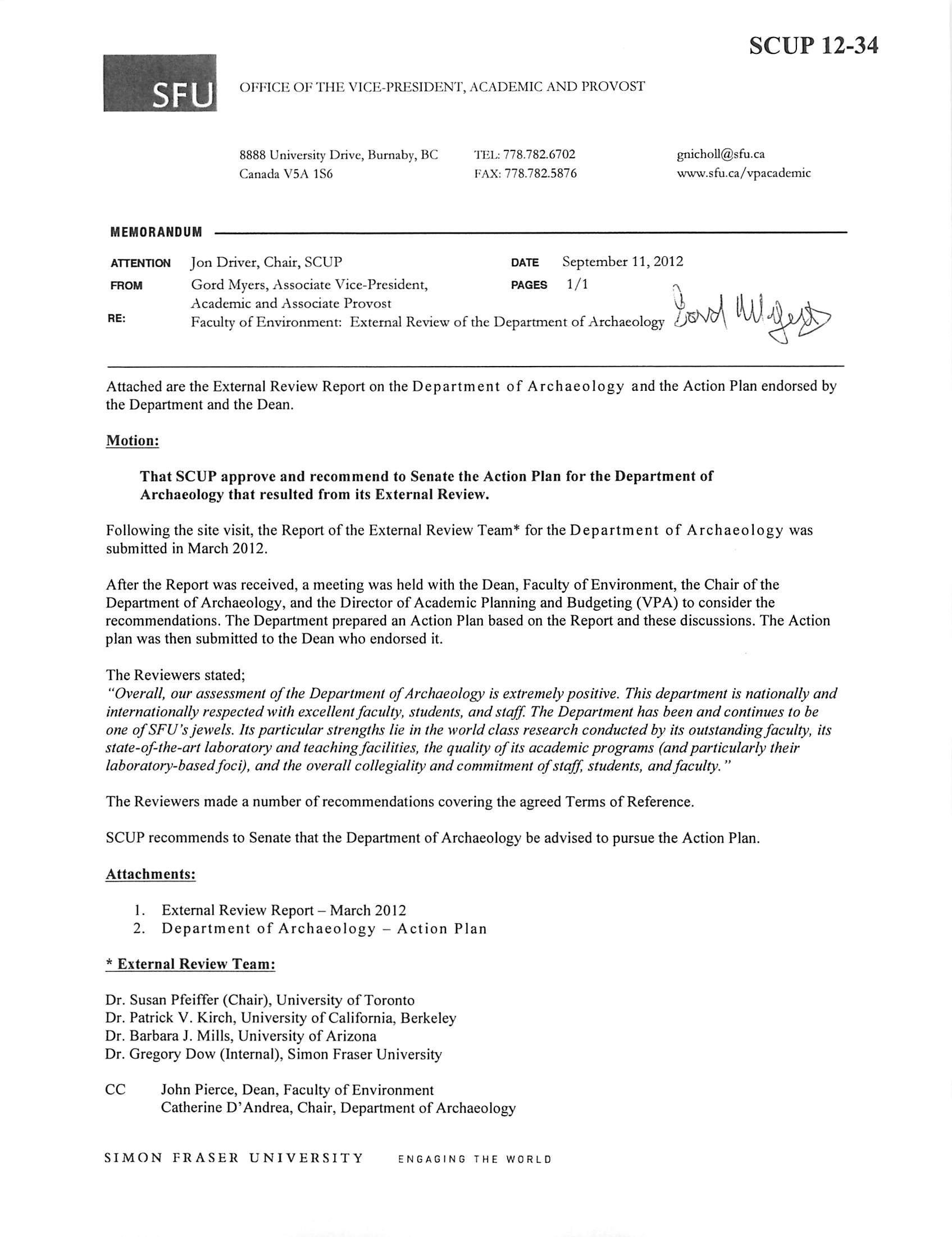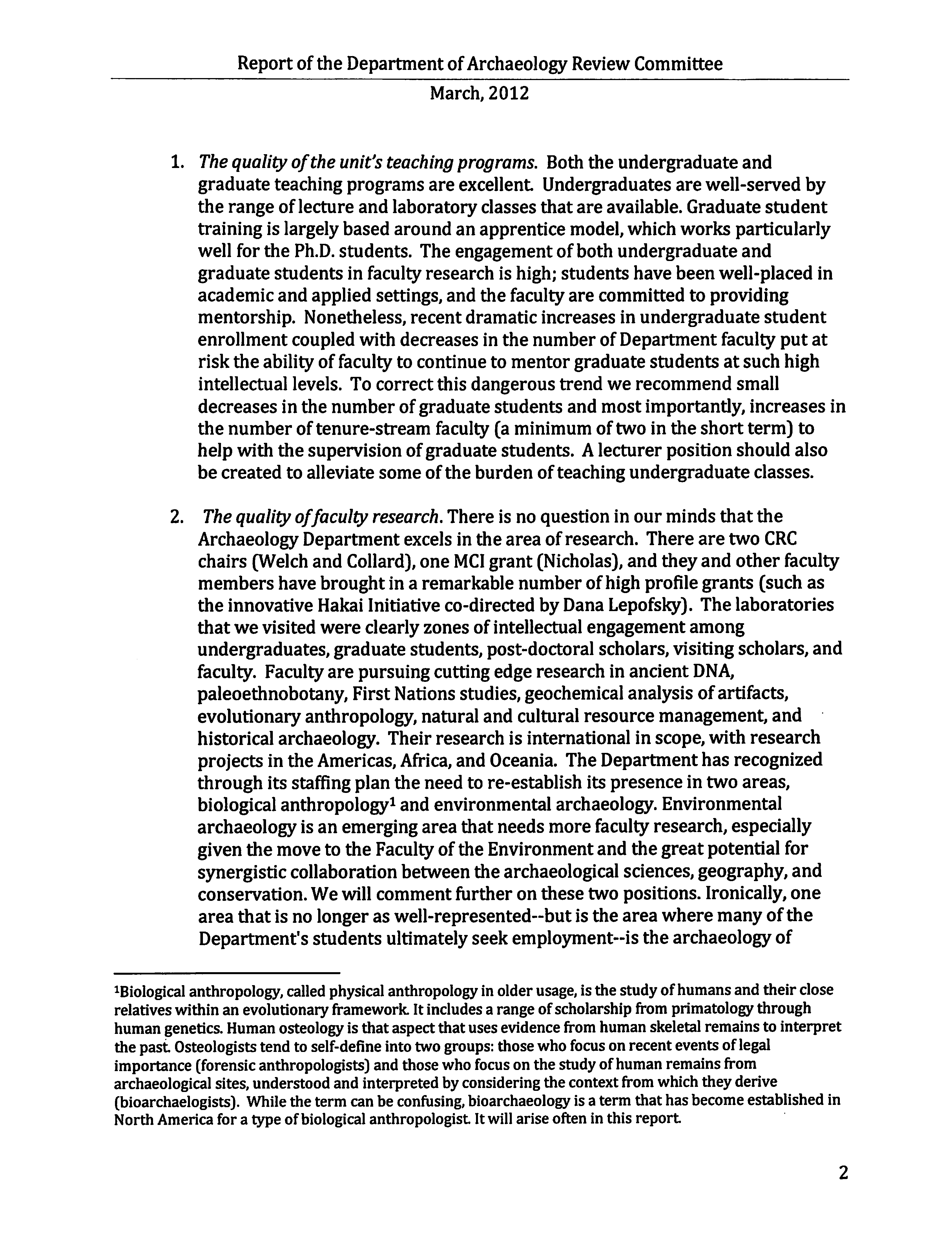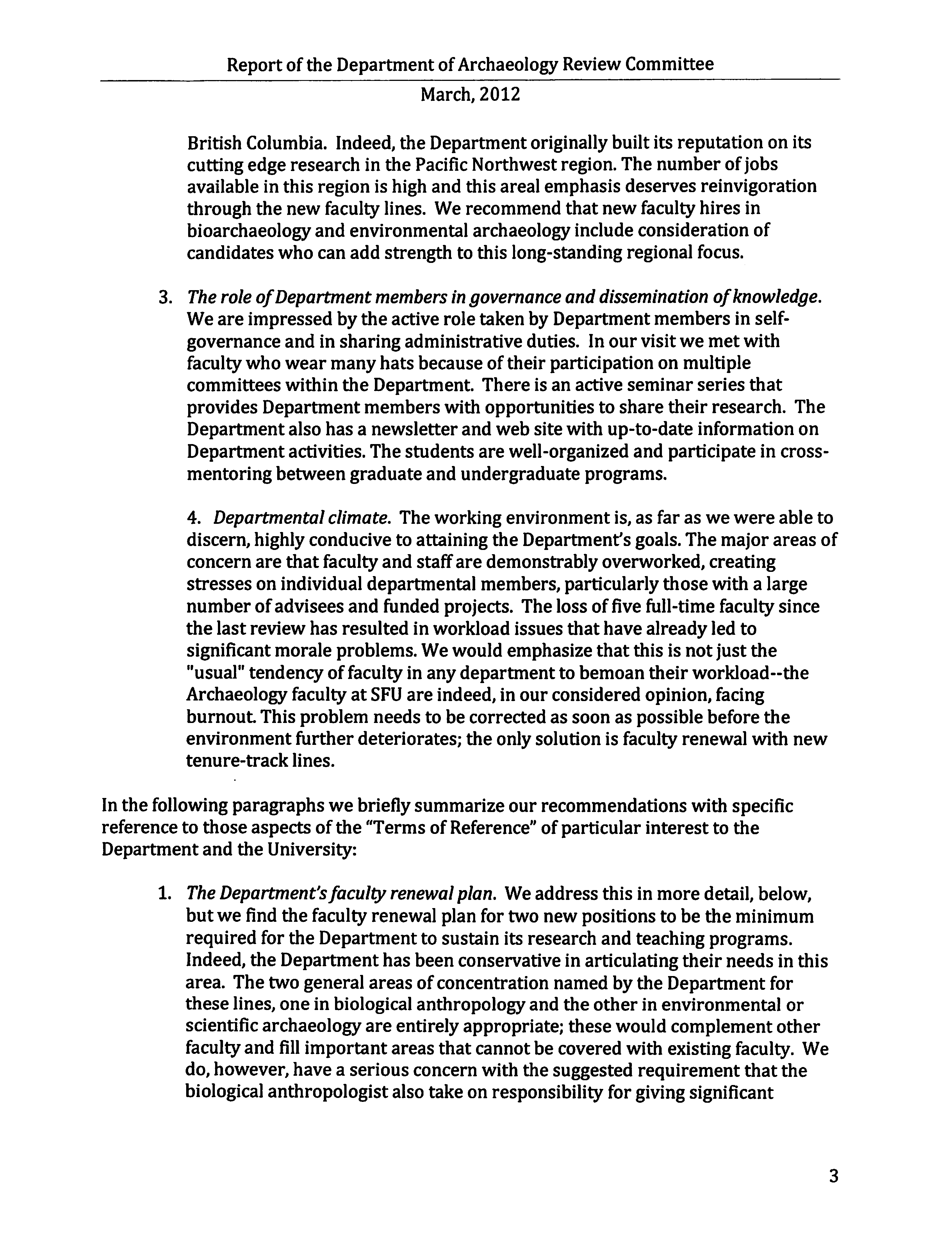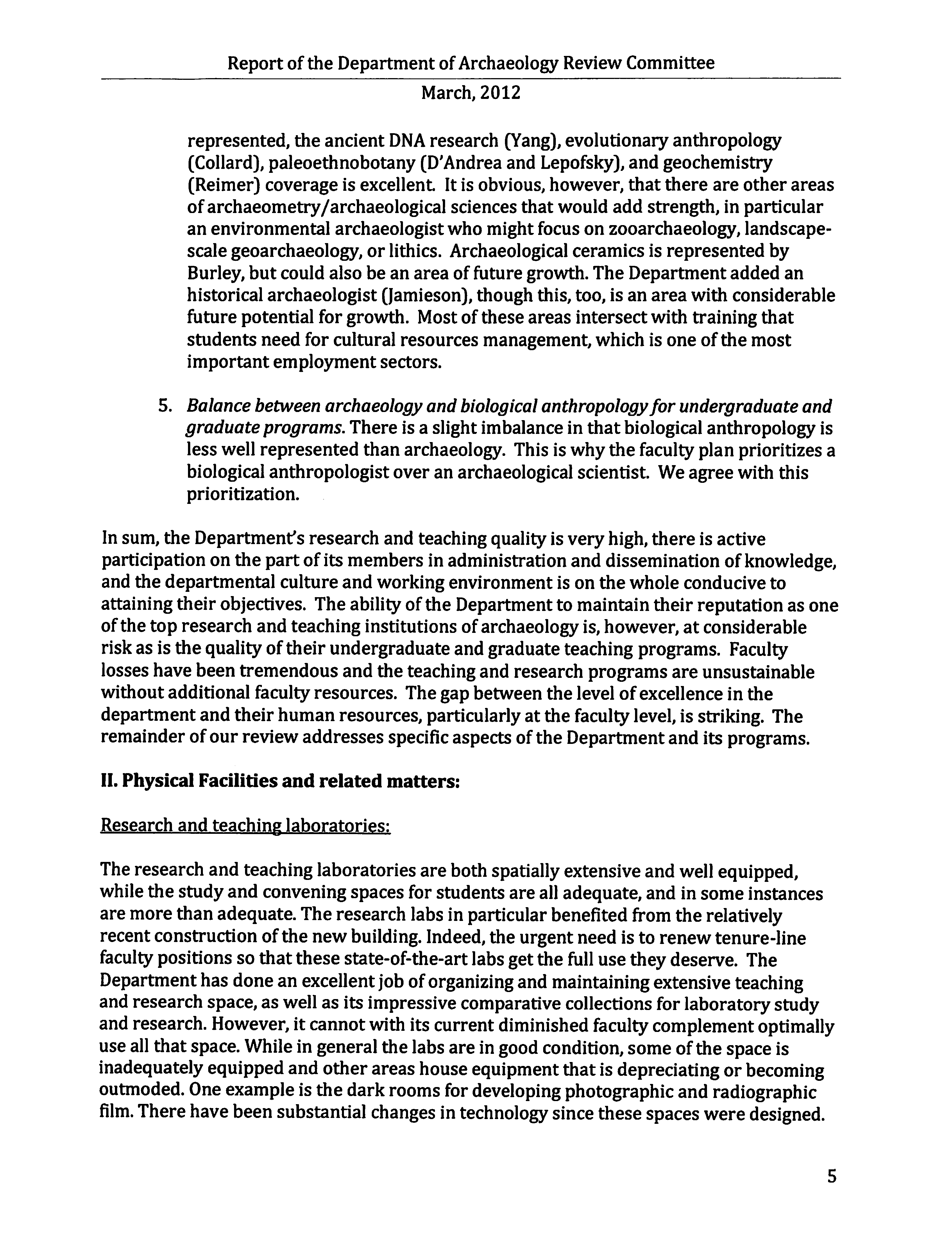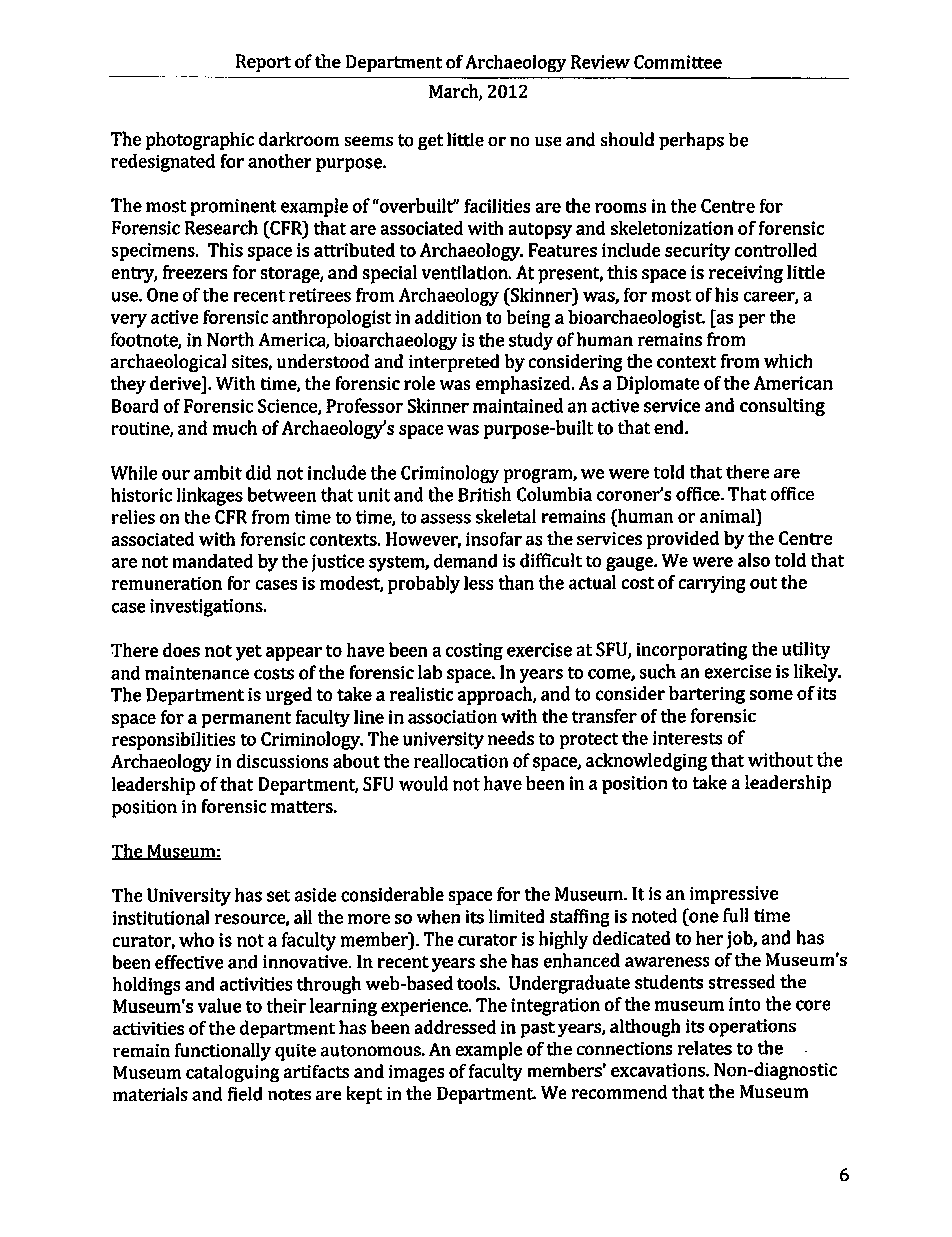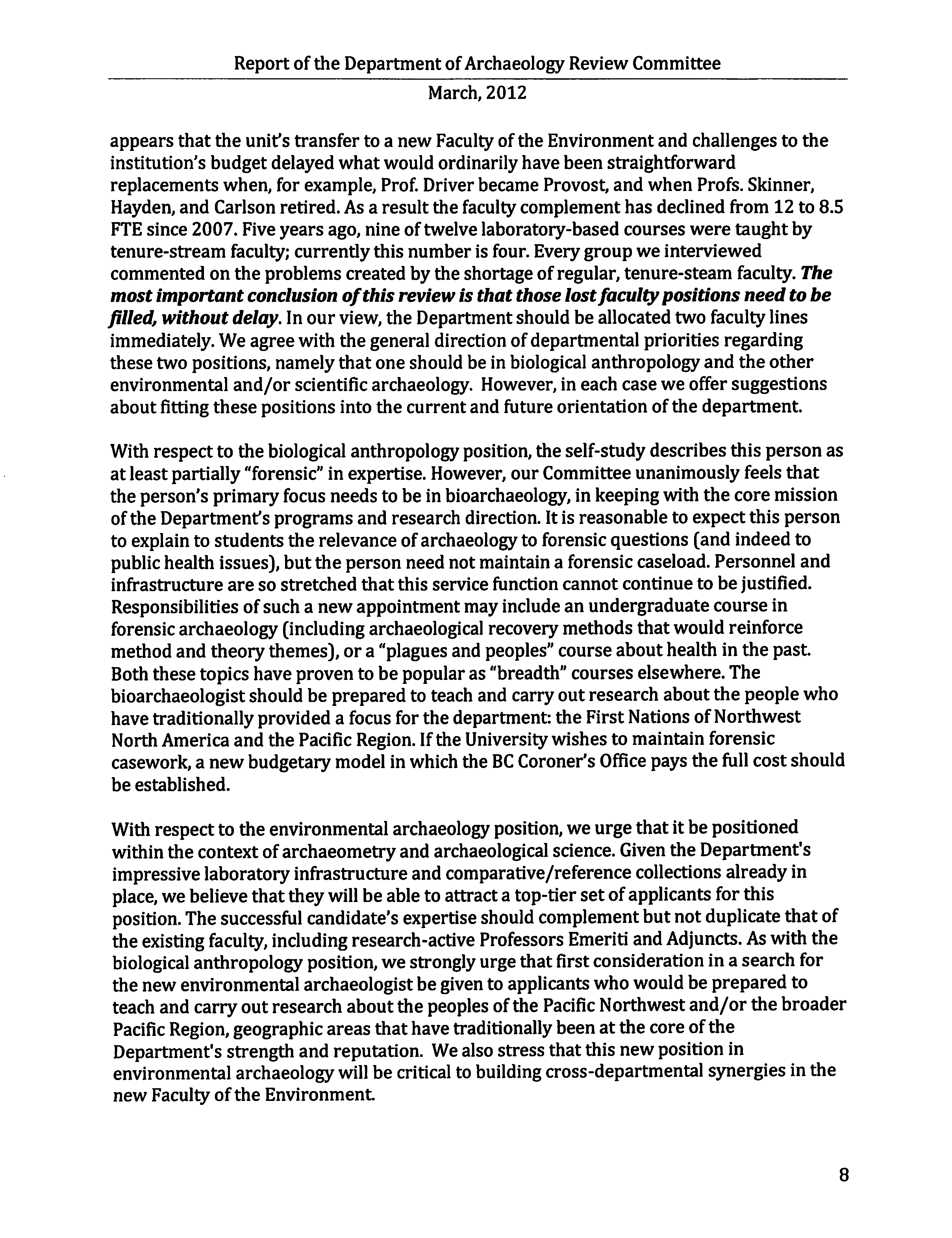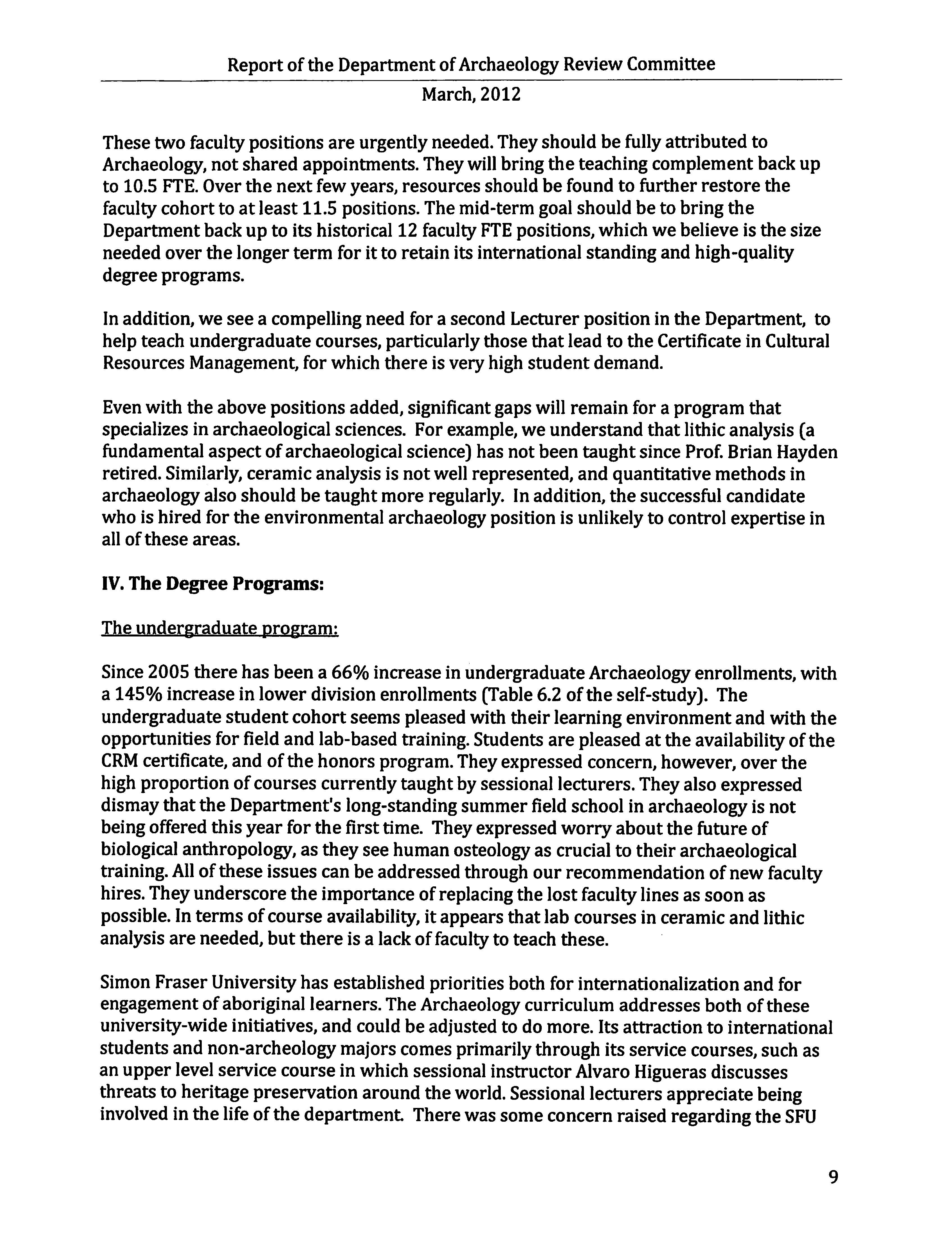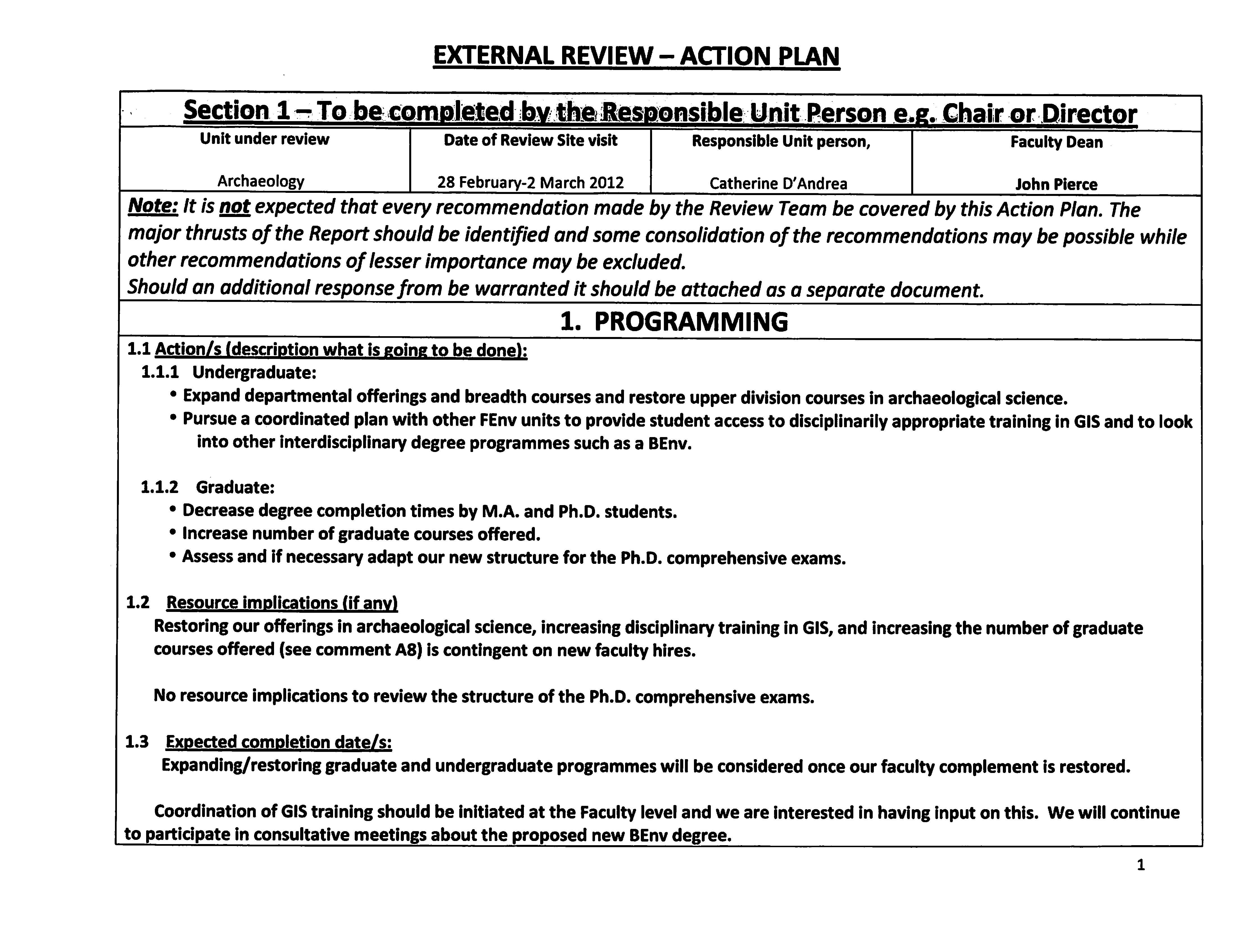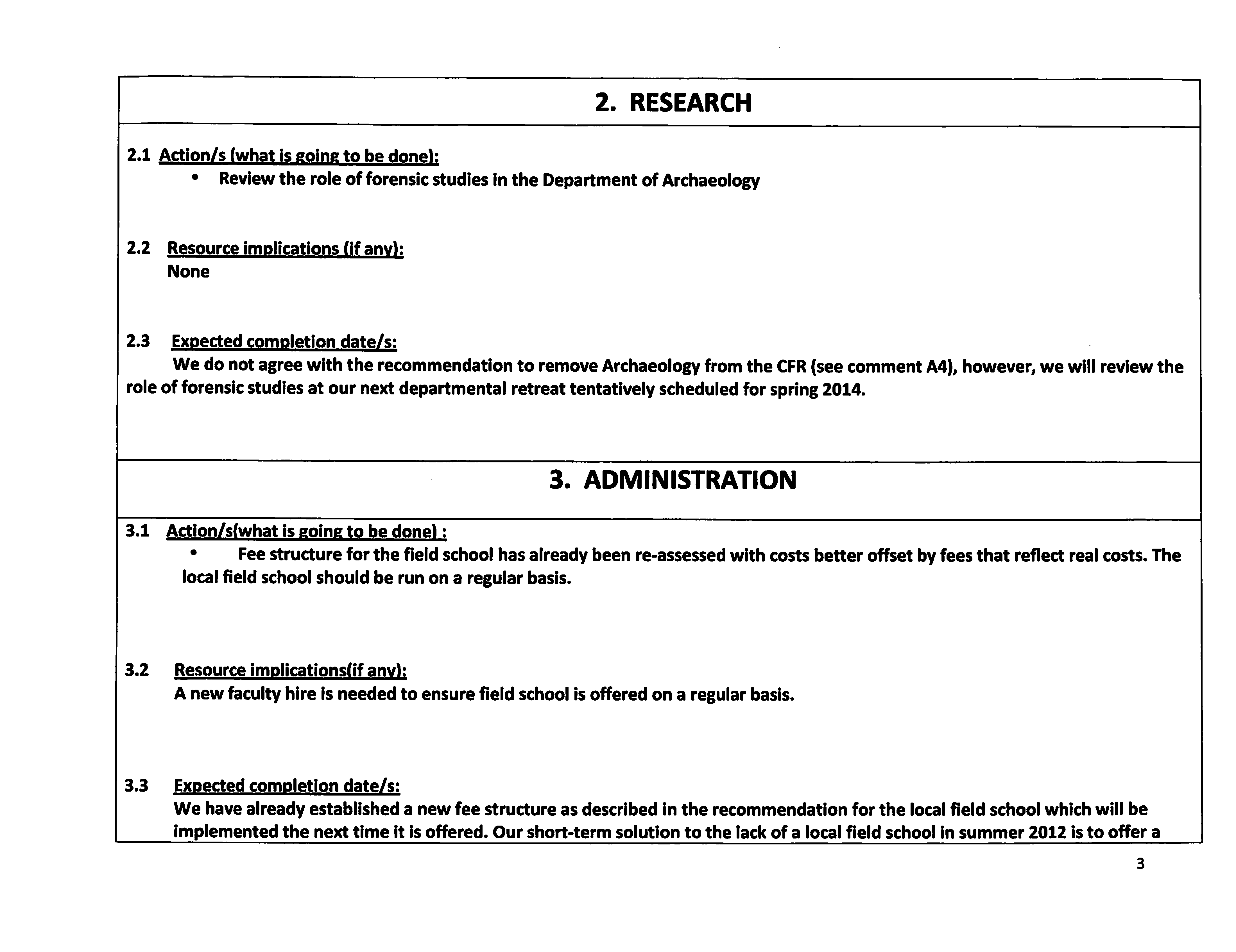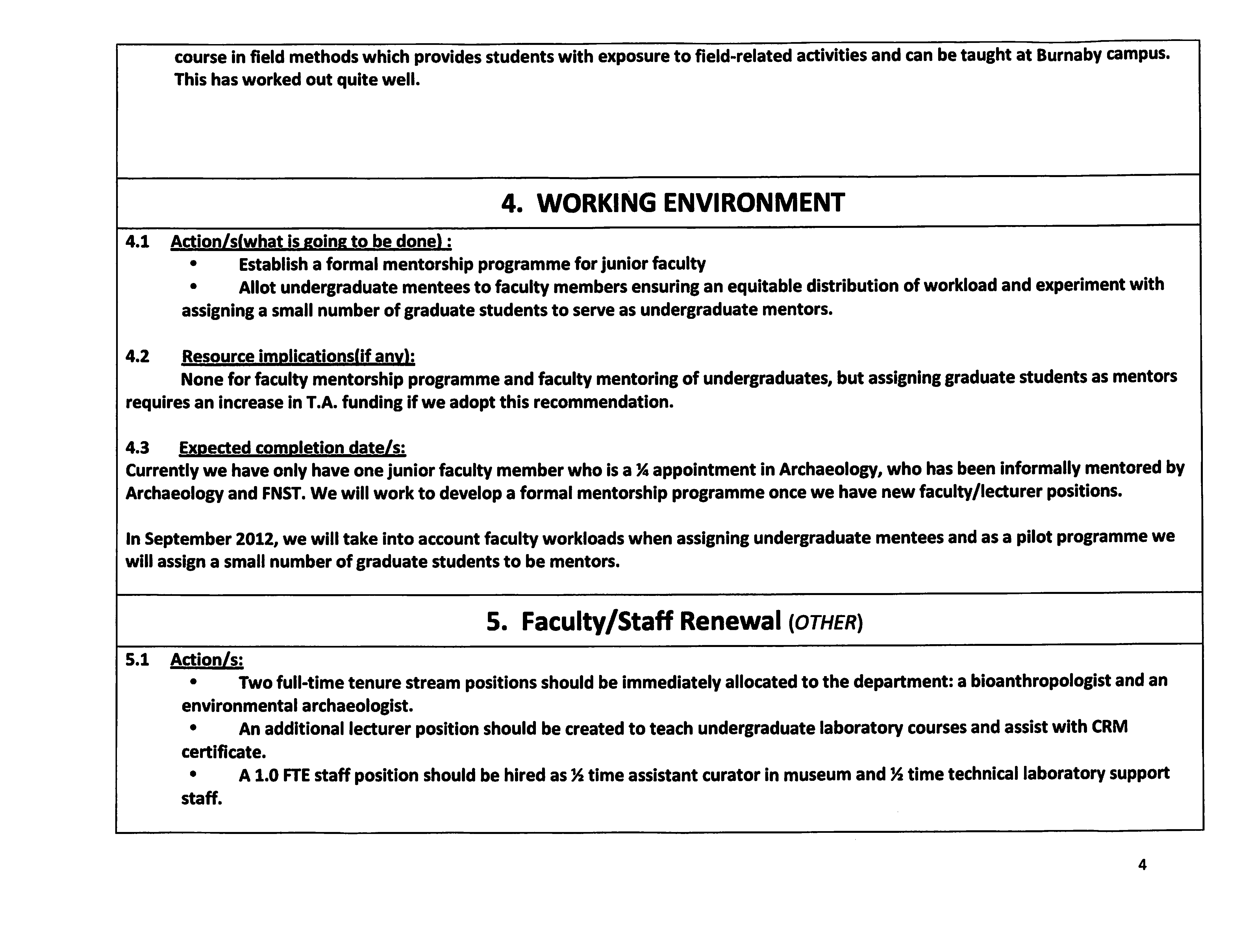SFU
MEMORANDUM
OFFICEOFTHE VICE-PRESIDENT, ACADKMIC AND PROVOST
8888 University Drive, Burnaby, BC
Canada Y5A 1S6
TEL: 778.782.3925
FAX: 778.782.5876
S.12-151
www.sfti.ca/vpacademic
attention Senate
date
September 26,2012
from
Jon Driver, Vice-President, Academic and
PAGES
1/1
Provost, and Chair, SCUP
Faculty of Environment: External Review of the Department of Archaeology (SCUP 12-34)
RE:
At its September 19, 2012 meeting SCUP reviewed and approved the Action Plan for the Department of
Archaeology that resulted from its External Review.
Motion:
That Senate approve the Action Plan for the Department of Archaeology that resulted from its External
Review.
end.
c: C. D'Andrea
J. Pierce
SIMON FRASER UNIVERSITY
engaging the world
SFU
SCUP 12-34
OFFICE OF THE VICE-PRESIDENT, ACADEMIC AND PROVOST
University Drive, Burnaby, BC
TEL: 778.782.6702
gnicholl@sfu.ca
Canada V5A1S6
www.sfu.ca/vpacademic
MEMORANDUM
ATTENTION
Jon Driver, Chair, SCUP
DATE
September 11, 2012
FROM
Gord Myers, Associate Vice-President,
PAGES
1/1
r\
Academic and Associate Provost
\J)
. I
RE:
Faculty of Environment: External Review of the Department of Archaeology
£j&vV\
J0W\
Attached are the External Review Report on the Department of Archaeology and the Action Plan endorsed by
the Department and the Dean.
Motion;
That SCUP approve and recommend to Senate the Action Plan for the Department of
Archaeology that resulted from its External Review.
Following the site visit, the Report of the External Review Team* for the Department of Archaeology was
submitted in March 2012.
After the Report was received, a meeting was held with the Dean, Faculty of Environment, the Chair of the
Department of Archaeology, and the Director of Academic Planning and Budgeting (VPA) to consider the
recommendations. The Department prepared an Action Plan based on the Report and these discussions. The Action
plan was then submitted to the Dean who endorsed it.
The Reviewers stated;
"Overall, our assessment ofthe Department ofArchaeology is extremely positive. Thisdepartment is nationally and
internationally respected with excellentfaculty, students, and staff. The Department has been and continues to be
one
ofSFU'sjewels. Its particular strengths lie in the world class research conducted by its outstandingfaculty, its
state-of-the-art laboratory and teaching facilities, the quality
ofits academic programs (and particularly their
laboratory-basedfoci), and the overall collegiality and commitment
ofstaff, students, andfaculty. "
The Reviewers made a number
of recommendations covering the agreed Terms of Reference.
SCUP recommends to Senate that the Department of Archaeology be advised to pursue the Action Plan.
Attachments:
1. External Review Report - March 2012
2. Department of Archaeology - Action Plan
* External Review Team:
Dr. Susan Pfeiffer (Chair), University of Toronto
Dr. Patrick V. Kirch, University of California, Berkeley
Dr. Barbara J. Mills, University
of Arizona
Dr. Gregory Dow (Internal), Simon Fraser University
CC
John Pierce, Dean, Faculty
of Environment
Catherine D'Andrea, Chair, Department of Archaeology
SIMON FRASER UNIVERSITY
ENGAGING the WORLD
Report of the Department of Archaeology Review Committee
March, 2012
External Committee Members:
Dr. Susan Pfeiffer (Chair), University of Toronto
Dr. Patrick V. Kirch, University of California, Berkeley
Dr. Barbara J. Mills, University of Arizona
Internal Committee Member:
Dr. Gregory Dow, Department of Economics
I. Introduction and Overview
This report summarizes the external committee'sreview of Simon Fraser University's
Department ofArchaeology. We thank the Department of Archaeology and SFU's
administration for inviting us, for their willingness to answer our many questions, and for
providing the detailed background documentation to allow us to perform our evaluation of
the program.
Our review took place over three days, February 29ththrough March 2nd. We initially met
with senior administrators at the downtown Vancouver campus, and then spent the
remainder ofour visit with faculty, staff, and students at the SFUmain campus in Burnaby.
During our three-day visit, we reviewed all key aspects ofthe department that are
summarized in the selfstudy. We toured the physical facilities, met with personnel, and
assessed department resources in the context of research, outreach, and teaching. We
discussed with colleagues the undergraduate and graduate programs. Conclusions and
recommendations arising from the review are not necessarily limited to any single aspect
of the department'smandate. They tend toward overarching themes of human resources,
graduate and undergraduate training programs, space, relations between neighboring
units, and conceptual strengths of the department
Overall, our assessment of the Department ofArchaeology is extremely positive. This
department is nationally and internationally respected with excellent faculty, students, and
staff. The Department has been and continues to be one of SFU'sjewels. Its particular
strengths lie in
the world class research conducted by its outstanding faculty, its state-of-
the-art laboratory and teaching facilities, the quality of its academic programs (and
particularly their laboratory-based foci), and the overall collegiality and commitment of
staff, students, and faculty. In terms of subject areas, the faculty and course strengths lie in
archaeological sciences, First Nations studies, and human evolutionary sciences. The
movement of Archaeology into the Faculty of the Environment is supported at all levels,
from the students to their Dean, and they are already engaged in visionary interdisciplinary
research
and training. We agree that this move into the new Faculty ofthe Environment is a
positive
step that opens up a number of exciting opportunities.
More specifically,
we now summarize our perspective on each ofthe four "Terms of
Reference:"
Report of the Department of Archaeology Review Committee
March, 2012
1.
The quality ofthe unit's teaching programs.
Both the undergraduate and
graduate teaching programs are excellent Undergraduates are well-served
by
the range of lecture and laboratory classes that are available. Graduate student
training is largely based around an apprentice model, which works particularly
well for
the Ph.D. students. The engagement of both undergraduate and
graduate students in faculty research is high; students have been well-placed in
academic and applied settings, and the faculty are committed to providing
mentorship. Nonetheless, recent dramatic increases in undergraduate student
enrollment coupled with decreases in the number of Department faculty put at
risk the ability of faculty to continue to mentor graduate students at such high
intellectual levels. To correct this dangerous trend we recommend small
decreases in the number of graduate students and most importantly, increases in
the number oftenure-stream faculty (a minimum of two in the short term) to
help with the supervision of graduate students. A lecturer position should also
be created to alleviate some ofthe burden ofteaching undergraduate classes.
2.
Thequality offaculty research.
There is no question in our minds that the
Archaeology Department excels in the area of research. There are two CRC
chairs (Welch and Collard), one MCI grant (Nicholas), and they and other faculty
members have brought in a remarkable number ofhigh profile grants (such as
the innovative Hakai Initiative co-directed by Dana Lepofsky). The laboratories
that we visited were clearly zones of intellectual engagement among
undergraduates, graduate students, post-doctoral scholars, visiting scholars, and
faculty. Faculty are pursuing cutting edge research in ancient DNA,
paleoethnobotany, First Nations studies, geochemical analysis of artifacts,
evolutionary anthropology, natural and cultural resource management, and
historical archaeology. Their research is international in scope,
with research
projects in the Americas, Africa, and Oceania. The Department has recognized
through its staffing plan the need to re-establish its presence in two areas,
biological anthropology1 and environmental archaeology. Environmental
archaeology is an emerging area that needs more faculty research, especially
given the move to the Faculty of the Environment and the great potential for
synergistic collaboration between the archaeological sciences, geography, and
conservation. We will comment further on these two positions. Ironically, one
area that is no longer as well-represented~but is the area where many ofthe
Department's students ultimately seek employment-is the archaeology of
biological anthropology,calledphysicalanthropologyin older usage,is the study of humans and their close
relatives within an evolutionary framework. It includes a range of scholarship from primatology through
human genetics. Human osteology is that aspect that uses evidence from human skeletal remains to interpret
the past Osteologists tend to self-define into two groups: those who focus on recent events of legal
importance (forensic anthropologists) and those who focus on the study of human remains from
archaeological sites, understood and interpreted by considering the context from which they derive
(bioarchaelogists). Whilethe term can be confusing, bioarchaeology is a term that has become established in
North America for a type of biological anthropologist It will arise often in this report
Report of the Department of Archaeology Review Committee
March, 2012
British Columbia. Indeed, the Department originally built its reputation on its
cutting edge research in the Pacific Northwest region. The number of jobs
available in this region is high and this areal emphasis deserves reinvigoration
through the new faculty lines. We recommend that new faculty hires in
bioarchaeology and environmental archaeology include consideration
of
candidates who can add strength to this long-standing regional focus.
3.
The role
ofDepartment members ingovernance and dissemination ofknowledge.
We are impressed by the active role taken by Department members in self-
governance and in sharing administrative duties. In our visit we met with
faculty who wear many hats because of their participation on multiple
committees within the Department. There is an active seminar series that
provides Department members with opportunities to share their research. The
Department also has a newsletter and web site with up-to-date information on
Department activities. The students are well-organized and participate in cross-
mentoring between graduate and undergraduate programs.
4.
Departmental climate.
The working environment is, as far as we were able to
discern, highly conducive to attaining the Department'sgoals. The major areas of
concern are that faculty and staff are demonstrably overworked, creating
stresses on individual departmental members, particularly those with a large
number ofadvisees and funded projects. The loss of five full-time faculty since
the last review has resulted in workload issues that have already led to
significant morale problems. We would emphasize that this is not just the
"usual" tendency of faculty in any department to bemoan their workload~the
Archaeology faculty at SFU are indeed, in our considered opinion, facing
burnout This problem needs to be corrected as soon as possible before the
environment further deteriorates; the only solution is faculty renewal with new
tenure-track lines.
In the following paragraphs we briefly summarize our recommendations with specific
reference to those aspects of the "Terms of Reference" of particular interest to the
Department and the University:
1.
The Department'sfaculty renewal plan.
We address this in more detail, below,
butwe find the faculty renewal plan for two new positions to be the minimum
required for the Department to sustain its research and teaching programs.
Indeed,
the Department has been conservative in articulating their needs in this
area.
The two general areas of concentration named by the Department for
these lines, one in biological anthropology and the other in environmental or
scientific archaeology are entirely appropriate; these would complement other
faculty and fill important areas that cannot be covered with existing faculty. We
do, however, have a serious concern with the suggested requirement that the
biological anthropologist also take on responsibility for giving significant
Report of the Department of Archaeology Review Committee
March, 2012
attention to the Forensics Center. We discuss this problematic issue in more
detail below.
2.
The Department's options for growth in staff.
The Department is fortunate to
have a dedicated and energetic staff. An area of particular concern is
the need
for growth in staffing the Museum. As previous review teams have repeatedly
pointed out, the Museum is an important resource for teaching. Moreover, it is
the repository for irreplaceable collections generated by the Department's
research programs. The current single curator line should be supplemented
by
at least a .50 FTE position to ensure that the collections are being adequately
maintained and made available for continuing research and education. The next
most challenging area for staff is in the technical and IT support for laboratories,
which is already inadequate for some projects. This will be addressed below. In
addition, the split job descriptions for some of its staffmembers, such as
budgeting/academic advisor, are areas
that could readily be justified as two
positions, especially in light of the significant growth in the undergraduate
program and enrollment in undergraduate classes.
3.
Best strategic optionsfor integration with the Faculty ofthe Environment.
The
Archaeology faculty are already well positioned to integrate with the Faculty of
the Environment One faculty member has a split appointment with the
Department of Resource and Environmental Management (REM) (Welch), while
another faculty member has a major funded project in collaboration with REM,
the Hakai Network (Lepofsky). These two projects provide excellent prototypes
for continued interaction and growth. Obvious areas for this kind of synergy
include the historical analysis of ecosystems transformation by human agents,
along
with their contemporary management and conservation. Some specific
areas of overlap include zooarchaeology with an emphasis on human impact and
modeling of resource abundance (e.g., salmon), and fire ecology through
micromorphology studies that would complement other geoarchaeological
approaches (e.g., PXRF geochemistry). We see opportunities with Geography
that are currently not being taken advantage of, particularly in remote sensing
and spatial analysis (e.g., Geographic Information Systems or GIS). GIS in
archaeology is a major area
of employment for students in applied and
university-based archaeology and could be much better integrated through
faculty and student research and training.
4.
New and emerging areas ofteaching and research for the Department.
The
Department is already at the cutting edge of many kinds of research and training
in archaeology, particularly in archaeological science and First Nations research.
The latter has been so successful that it has budded offto form a new program,
with courtesy (Nicholas and Welch) and cross-appointments with the
Archaeology Department (Yellowhorn and Reimer). These cross-appointments
need to be carefully nurtured to ensure that workloads in both programs remain
balanced. In terms of the range of archaeological sciences that are already
Report of the Department of Archaeology Review Committee
March, 2012
represented, the ancient DNA research (Yang), evolutionary anthropology
(Collard), paleoethnobotany (D'Andreaand Lepofsky), and geochemistry
(Reimer) coverage is excellent It is obvious, however, that there are other areas
of archaeometry/archaeological sciences that would add strength, in particular
an environmental archaeologist who might focus on zooarchaeology, landscape-
scale geoarchaeology, or lithics. Archaeological ceramics is represented by
Burley, but could also be an area of future growth. The Department added an
historical
archaeologist (Jamieson), though this, too, is an area with considerable
future potential for growth. Most of these areas intersect with training that
students need for cultural resources management, which is one ofthe most
important employment sectors.
5.
Balance between archaeology and biological anthropologyfor undergraduate and
graduate programs.
There is a slight imbalance in
that biological anthropology is
less well
represented than archaeology. This is why the faculty plan prioritizes a
biological anthropologist over an archaeological scientist. We agree with this
prioritization.
In sum, the Department'sresearch and teaching quality is very high, there is active
participation on
the part of its members in administration and dissemination of knowledge,
and the departmental culture and working environment is on the whole conducive to
attaining their objectives. The ability of the Department to maintain their reputation as one
of the
top research and teaching institutions of archaeology is, however, at considerable
risk as is the quality of their undergraduate and graduate teaching programs. Faculty
losses have been tremendous and the teaching and research programs are unsustainable
without additional faculty resources. The gap between the level of excellence in the
department and their human resources, particularly at the faculty level, is striking. The
remainder of our review addresses specificaspects of the Department and its programs.
II. Physical Facilities and related matters:
Research and teaching laboratories:
The research and teaching laboratories are both spatially extensive and well equipped,
while the study and convening spaces for students are all adequate, and in some instances
are more than adequate. The research labs in particular benefited from the relatively
recent construction of the new building. Indeed, the urgent need is to renew tenure-line
faculty positions so that these state-of-the-art labs get the full use they deserve. The
Departmenthas done an excellentjob oforganizing and maintaining extensiveteaching
and research space, as well as its impressive comparativecollections for laboratory study
and research. However, it cannot with its current diminished faculty complement optimally
use all that space. While in general the labs are in goodcondition, some ofthe space is
inadequately equipped and other areas house equipmentthat is depreciating or becoming
outmoded.
One exampleis the dark rooms for developing photographicand radiographic
film. Therehavebeen substantial changes in technology sincethese spaces were designed.
Report of the Department of Archaeology Review Committee
March, 2012
The photographic darkroom seems to get little or no use and should perhaps be
redesignated for another purpose.
The most prominent example of"overbuilt" facilities are the rooms in the Centre for
Forensic Research (CFR) that are associated with autopsy and skeletonization of forensic
specimens. This space is attributed to Archaeology. Features include security controlled
entry, freezers for storage, and special ventilation.
At present, this space is receiving little
use. One
of the recent retirees from Archaeology (Skinner) was, for most of his career, a
very active forensic anthropologist in addition to being a bioarchaeologist [as per the
footnote, in North America, bioarchaeology is the study of human remains from
archaeological sites,
understood and interpreted by considering the context from which
they derive]. With time, the forensic role was emphasized. As a Diplomate of the American
Board of Forensic Science, Professor Skinner maintained an active service and consulting
routine, and much of Archaeology's space was purpose-built to that end.
While
our ambit did not include the Criminology program, we were told that there are
historic linkages between that unit and the British Columbia coroner's office. That office
relies on the CFR from time to time, to assess skeletal remains (human or animal)
associated with forensic contexts. However, insofar as the services provided by the Centre
are not mandated by the justice system, demand is difficult to gauge. We were also told that
remuneration for cases is modest, probably less than the actual cost of carrying out the
case investigations.
There does not yet appear to have been a costing exercise at SFU, incorporating the utility
and maintenance costs ofthe forensic lab space. In years to come, such an exercise is likely.
The Department is urged to take a realistic approach, and to consider bartering some ofits
space for a permanent faculty line in association with the transfer of the forensic
responsibilities to Criminology. The university needs to protect the interests
of
Archaeologyin discussions about the reallocation of space,acknowledging that without the
leadership
ofthat Department, SFU would not have been in a position to take a leadership
position in forensic matters.
The Museum:
The University has set aside considerable space for the Museum. It is an impressive
institutional resource, all the more so when its limited staffing is noted (one full time
curator, who is not a faculty member). The curatoris highly dedicated to her job,and has
been effective and innovative. In recent years she has enhanced awareness of the Museum's
holdings and activities through web-based tools. Undergraduate students stressed the
Museum's value to their learning experience. The integrationofthe museum into the core
activities of the department has been addressed in past years, although its operations
remain functionally quite autonomous. An example of the connections relates to the
Museum cataloguingartifacts and images of faculty members' excavations. Non-diagnostic
materials and field notes are kept in the Department.We recommend that the Museum
Report of the Department of Archaeology Review Committee
March, 2012
work with the Library and the University Archives (where appropriate) to ensure that all
documentation of excavations by faculty members are properly archived.
The Museum is perceived as centrally
important to the Department Largely because of its
very limited infrastructural support, the curator is planning an internship program through
which curatorial activities can occur. This should be considered a pilot program, as it is not
clear whether staffing is adequate to execute the program. We strongly recommend that a
permanent part-time staff position be added to the personnel complement ofthe Museum,
to assure its function in the years to come.
III. Departmental Personnel:
Support staff:
The quality ofthe staffand faculty is impressive. Their collective commitment to the
mission of their department and the university was consistently conveyed. Support staff,
contract teachers and permanent faculty are well trained and fully engaged in their
collective mission. One area of weakness was consistently noted, however, in the area of IT
support. Current support of both high level computing and day-to-day computer support
for faculty and students falls on the laboratory technical staff, who have many other
responsibilities and were never trained specifically in IT. We recommend that the Dean of
the Faculty ofthe Environment review staffing across all three departments to assure that
staffing with respect to IT support is adequate. Some centralization of IT support within the
Faculty would seem a reasonable objective.
Teaching/research faculty performance:
In our opinion, the demonstrated quality of research being pursued by regular faculty is
exemplary.
Measures of research impact for faculty are impressive; these include citation
indices (such as the ISIWeb of Science h-index) which leave no doubt as to the high
productivity and international visibility ofthe Department'sfaculty. This small cohort has
achieved linkages with international bodies like the Chinese Academy of Social Science.
Two are CRC chairs. They hold major grants from both external (SSHRC-MCRI) and internal
(CTEF) bodies, as well as charitable foundation (the Hakai Network). It is a credit to the
departmental chair that the teaching release components of these programs have been
handled so well, with generally excellent lecturers keeping the program going. Faculty and
student research receives attention from local and broader communities, and the pace of
publication is good. While they have generated substantial external grant support, it
appears that are not currently realizing any benefit for this productivity through the Tri-
Council indirect costs program. We recommend that the Dean ofthe Faculty of the
Environment establish a practice in which a portion ofthe funds directed to the Faculty is
conveyed to the Department. An in-house monograph series, Arch Press, might better serve
the Department if it were converted to an on-line resource.
Because of recent departures arising from retirements and administrative shifts, the
Department is most notably short-staffed with regard to tenure-line faculty members. It
Report of the Department of Archaeology Review Committee
March, 2012
appears that the unifs transfer to a new Faculty of the Environment and challenges to the
institution's budget delayed what would ordinarily have been straightforward
replacements when, for example, Prof. Driver became Provost, and when Profs. Skinner,
Hayden,
and Carlson retired. As a result the faculty complement has declined from 12 to 8.5
FTE since 2007. Five years ago, nine of twelve laboratory-based courses were taught by
tenure-stream faculty; currently this number is four. Every group we interviewed
commented on the problems created by the shortage of regular, tenure-steam faculty.
The
most important conclusion ofthis review is that those lost faculty positions need to be
filled, without delay.
In our view, the Department should be allocated two faculty lines
immediately. We agree with
the general direction of departmental priorities regarding
these
two positions, namely that one should be in biological anthropology and the other
environmental and/or scientific archaeology. However, in each case we offer suggestions
about fitting these positions into the current and future orientation of the department.
With respect to the biological anthropology position, the self-study describes this person as
at least partially "forensic" in expertise. However, our Committee unanimously feels
that
the person'sprimary focus needs to be in bioarchaeology, in keeping with the core mission
of the Department'sprograms and research direction. It is reasonable to expect this person
to explain to students the relevance of archaeology to forensic questions (and indeed to
public health issues), but the person need not maintain a forensic caseload. Personnel and
infrastructure are so stretched that this service function cannot continue to be justified.
Responsibilities of such a new appointment may include an undergraduate course in
forensic archaeology (including archaeological recovery methods that would reinforce
method and theory themes), or a "plagues and peoples" course about health in the past.
Boththese topics have proven to be popular as "breadth" courses elsewhere. The
bioarchaeologist should be prepared to teach and carry out research about the people who
have traditionally provided a focus for the department: the First Nations of Northwest
North America and the Pacific Region. If the University wishes to maintain forensic
casework, a new budgetary model in which the BC Coroner'sOffice pays the full cost should
be established.
Withrespect to the environmental archaeology position, we urge that it be positioned
within the context of archaeometry and archaeologicalscience. Given the Department's
impressivelaboratory infrastructure and comparative/reference collections already in
place, we believethat they will be able to attract a top-tier set of applicants for this
position. Thesuccessful candidate'sexpertise should complement but not duplicate that of
the
existing faculty, including research-active Professors Emeriti andAdjuncts. As withthe
biological anthropology position, we strongly urge that first consideration in a search for
the new environmental archaeologist be givento applicants who would be prepared to
teachand carry out research about the peoples ofthe Pacific Northwestand/or the broader
Pacific Region, geographic areas that have traditionally been at the core of the
Department'sstrength and reputation. Wealso stress that this new position in
environmental archaeologywill be critical to building cross-departmental synergies in the
new Faculty ofthe Environment
Report of the Department of Archaeology Review Committee
March, 2012
These two faculty positions are urgently needed. They should be fully attributed to
Archaeology,
not shared appointments. They will bring the teaching complement back up
to 10.5 FTE.Over the next few years, resources should be found to further restore the
faculty cohort to at least 11.5 positions. The mid-term goal should be to bring the
Department back up to its historical 12 faculty FTEpositions, which we believe is the size
needed
over the longer term for it to retain its international standing and high-quality
degree programs.
In addition, we see a compelling need for a second Lecturer position in the Department, to
help
teach undergraduate courses, particularly those that lead to the Certificate in Cultural
Resources Management, for which there is very high student demand.
Even with the above positions added, significant gaps will remain for a program that
specializes in archaeological sciences. For example, we understand that lithic analysis (a
fundamental
aspect of archaeological science) has not been taught since Prof. Brian Hayden
retired. Similarly, ceramic analysis is
not well represented, and quantitative methods in
archaeology also should be taught more regularly. In addition, the successful candidate
who is hired for the environmental archaeology position is unlikely to control expertise in
all ofthese areas.
IV. The Degree Programs:
The undergraduate program:
Since 2005 there has been a 66% increase in undergraduate Archaeology enrollments, with
a 145% increase in lower division enrollments (Table 6.2 of the self-study). The
undergraduate student cohort seems pleased with their learning environment and with the
opportunities for field and lab-based training. Students are pleased at the availability of the
CRM certificate, and of the honors program. They expressed concern, however, over the
high proportion of courses currently taught by sessional lecturers. They also expressed
dismay that the Department's long-standing summer field school in archaeology is not
being offered this year for the first time. They expressed worry about the future of
biological anthropology, as they see human osteology as crucial to their archaeological
training. All of these issues can be addressed through our recommendation of new faculty
hires. They underscore the importance of replacing the lost faculty lines as soon as
possible. In terms of course availability, it appears that lab courses in ceramic and lithic
analysis are needed, but there is a lack of faculty to teach these.
Simon Fraser University has established priorities both for internationalization and for
engagement
of aboriginal learners. The Archaeology curriculum addresses both of these
university-wide initiatives, and could be adjusted to do more. Its attraction to international
students and non-archeology majors comes primarily through its service courses, such as
an upper level service course in which sessional instructor Alvaro Higueras discusses
threats to heritage preservation around the world. Sessional lecturers appreciate being
involved in the life of the department There was some concern raised regarding the SFU
Report of the Department of Archaeology Review Committee
March, 2012
policy and practice relating to grading norms. Some additional attention should be directed
toward this, especially at a
time when such a large proportion of the undergraduate
curriculum is in the hands of the sessional instructors.
We are very impressed with the Department'sefforts to attract and retain aboriginal
students. With two faculty members cross-appointed to the First Nations program, and
others with courtesy appointments, Archaeology may be in a better position than any other
North American program to achieve shared goals and forge new understandings with
aboriginal communities. However, the numbers of faculty and students are small and the
challenges are substantial. We are guardedly optimistic for the future in this area.
The categorization of most Archaeology courses as BA courses is a fundamental
incongruity. Our Committee suggests
that once the two recommended new faculty are in
place the Department should seriously explore the possibility of better integration into SFU
undergraduate science programs. The addition of a BSc option in Archaeology would
attract a broader range of students and would better prepare some students for MSc
studies. Another option might be a Bachelor's inEnvironmental Studies, building on the
strengths of the department and their new position in the Faculty of the Environment. We
recommend that the Archaeology Department pursue a coordinated plan with the other
Faculty
of Environment departments so that students (undergraduate and graduate) have
access to disciplinarily appropriate training in
GIS applications and to consider other
interdisciplinary degree programs.
In addition to courses for majors, more Archaeology courses could be designed for the
Writing, Quantitative, and Breadth (WQB) requirements. A lower division writing
intensive course currently is
not offered and would be a good way for the Department to
continue to expand enrollments, once the faculty complement is enhanced.
The graduate program:
The Archaeology graduate program is unique in North America, with an established
reputation for disciplinary training oriented toward the archaeological sciences and the
geographic regions of the Pacific Northwestaswell asthe broaderPacific Region. Many of
their doctoral graduates are very well placed in academicand CRM positions. Faculty
members take a keen interest in the graduate programs, and make adjustments when
things are not working smoothly. The newly modified comprehensive examination process
in the doctoral program is an example of this.We urge the Department to attend to some
points of uncertainty in the new
plan, and to establish a time limit for each of the three
required essays in the new program.
Mostof the challenges facing the graduate program are linked to the understaffing of
faculty positions, as already noted. Several faculty members currentlyhavevery large
numbers of graduate advisees. Faculty membersidentifythe recruitmentand retention of
high quality graduate students as an ongoing challenge. Time to completion and the
proportionof registered students who fail to completeare cause for some concernand
10
Report of the Department of Archaeology Review Committee
March, 2012
these are again partially related to understaffing of faculty. We recommend that the
Graduate Dean work with the Department to develop a template for multi-year funding
offers to doctoral applicants. Funding commitments should include funds from teaching
assistantships, institutional scholarships, and external research
grants to faculty advisors.
The number ofstudents admitted to MAand PhD programs should be reduced modestly, in
light
of advising loads.
The doctoral program is designed to emphasize independent work and mentoring. We
were told that no other program at SFUhas so few required courses. Our discussions
explored this topic, and while we have some concern over the small amount of formal
training
of the cohort, we have no specific alternative to suggest at this time. An issue for
faculty members is the large number of individual graduate reading courses they supervise
for no credit. More graduate courses could lighten this burden. Courses in biological
anthropology theory and quantitative methods would be especially appropriate. We
recommend
that once the faculty complement has been increased, the masters and doctoral
curricula be reviewed
with the possibility of increasing the number of required courses for
both degrees. The graduate curriculum could be expanded to include GIS, which would be a
way of further integrating with other Faculty ofthe Environment - particularly in an area
that currently has so much potential for growth and student employment
Relationship of the Archaeology Department to other SFUunits:
The Department of Archaeology chose to join the newly established Faculty of the
Environment in 2011. Its relations with the other two units in that Faculty are good.
Archaeology faculty and REMfaculty share research enterprises, and there is a developing
sense that technical expertise (for example, in GIS) can be shared across the units. As noted
in the selfstudy, students have expressed concern that Archeolog/s position in the Faculty
of the Environment could compromise their access to biological anthropology, especially if
it is predominantly forensic in its orientation. However, if
that position is framed primarily
as bioarchaeology,
the resulting emphasis on human adaptation to past environments will
fit very well.
V. Recommendations:
A. Pertaining to the Department of Archaeology:
Al: Renewal of faculty complement: Two full time
tenure stream positions should be
immediately allocated to
the Department of Archaeology. In keeping with the unit's
priorities, these positions should be for a biological anthropologist with primary interest in
bioarchaeology, and for an environmental archaeologist with a specialization in some area
of archaeological science. In both cases, preferred candidates should be prepared to focus
particularly on archaeological questions of the Pacific Northwest and/or the broader
Pacific Region.
11
Report of the Department of Archaeology Review Committee
March, 2012
A2: An additional lecturer position should be created to teach undergraduate laboratory
based classes and assist with the Certificate in Cultural Resources Management.
A3: The current single Museum curator line should be supplemented by at least a .50 FTE
position to ensure that the collections are being adequately maintained and made available
for continuing research and education.
A4: Review the role of forensic studies in the Department of Archaeology: Following the
departure of the one faculty member for which forensics was a primary focus, the
Department should consolidate its activities, removing itself from ongoing shared
responsibilities
with the School of Criminology at the Centre for Forensic Science, moving
toward collaborations on a case-by-case basis.
A5:
We endorse the recent revisions to the undergraduate curriculum, and encourage the
department to expand its offerings of breadth courses, through topics like "plagues and
peoples," as well as classifying
some upper level courses as science courses in order to
make them more suitable for science students.
A6: The Department ofArchaeology should pursue a coordinated plan with the other
Faculty of the Environment departments so that students (undergraduate and graduate)
have access to disciplinarily appropriate training in GIS applications and to look into other
interdisciplinary degree programs, such as a Bachelor's in Environmental Studies.
A7: The number of graduate students should be decreased slightly to ensure that there is
adequate funding and supervision for those students accepted to the program. Oncethe
complement of faculty has been restored, the ideal number of graduate admission can be
reviewed.
A8: Oncethe graduate faculty complement has been increased, the masters and doctoral
curricula should be reviewed with strong consideration given to increasing the number of
required courses for both degrees.
A9:We believe that the new comprehensive examination structure for the PhD degree is
very good,but the open-endedness of the essay progressis already of concern to students,
as is the question of consistency in what the exam entails among faculty. We recommend
that the new structure be more explicitly discussed among the faculty and that there be a
specified time limit for completion.
A10:The Department and the Museum should collaborate with the University Libraryto
archive the records oftheir past researchers and to move toward electronic formats for its
publication series, Arch Press.
All: The fee structure for the archaeology field school needs to be reassessed, as it has not
been covering the full costs of the program. In addition, the field school should be offered
on a regularbasis,with its cost fully offset by fees that adequately reflect the real costs of
12
Report of the Department of Archaeology Review Committee
March, 2012
running the program. Meanwhile, if it is not being offered, then the other options for the
undergraduates in the area should be made clear early enough in the spring for them to
apply to other programs.
A12: A formal mentorship program should be established for junior faculty. This should
not just be a single faculty member,
but should use the mentoring mosaic model, where one
outside and one inside faculty member
are assigned when the faculty member is hired.
A13: The assignment of undergraduate mentees to faculty should take into account the
faculty members' FTEwithin the Department to make sure that faculty work loads are
equitable. The Department might consider assigning one or two graduate students to serve
as undergraduate mentors with TAmonies (and the administration should consider adding
these assistantships to the TA funding for the Department).
B. Pertaining to
the SFUAdministration:
Bl: Establish as standard practice that the Faculty of the Environment pass on a share of
"indirect costs" from the federal granting agencies to the Department.
B2: Provide centralized Faculty-level IT support to all departmental units including
Archaeology.
B3:
The Dean of Graduate Studies should provide the graduate faculty and graduate
administrator with the detailed, ongoing support needed for them to more effectively
recruit and maintain an outstanding graduate cohort, with multi-year plans for student
funding.
C. Recommendations Pertaining to the Review Process:
CI: The Committee believes that the review process could have been completed in two
days, and suggests that a two-day option be available.
C2:The Dean of the Graduate School should provide standardized data to each selfstudy,
summarizing variables that would ideally include graduate applications, offers, and
acceptances, mean and median times to degrees, measures related to attrition, the amount
and nature of financial support.
C3: A standardized report from the head Librarian, assessing the adequacy of holdings and
engagement, should be appended to the self-study. The interview with Library staff could
then be made optional.
13
EXTERNAL REVIEW - ACTION PLAN
Section 1 - To be completed bv the Responsible Unit Person e.g. Chair or Director
Unit under review
Archaeology
Date of Review Site visit
28 February-2 March 2012
Responsible Unit person,
Catherine D'Andrea
Faculty Dean
John Pierce
Note:
It is
not
expectedthat every recommendation made bythe Review Team be covered bythis Action Plan. The
major thrusts of the Report should be identified andsomeconsolidation of therecommendations may bepossible while
otherrecommendations oflesserimportance maybe excluded.
Should an additional responsefrom be warranted it should be attached as aseparate document.
1. PROGRAMMING
1.1 Action/s (description what is going to be done):
1.1.1 Undergraduate:
• Expand departmental offerings and breadth courses and restore upper division courses in archaeological science.
• Pursue a coordinated planwith other FEnv units to provide student access to disciplinarily appropriate training in GIS and to look
into other interdisciplinary degree programmes such as a BEnv.
1.1.2 Graduate:
• Decrease degree completion times by M.A. and Ph.D. students.
• Increase number of graduate courses offered.
• Assess and if necessary adapt our new structure for the Ph.D. comprehensive exams.
1.2 Resource Implications (if anv)
Restoringour offerings in archaeological science, increasing disciplinary training in GIS, and increasing the number of graduate
courses offered (see comment A8) is contingent on new faculty hires.
No resource implications to review the structure of the Ph.D. comprehensive exams.
1.3 Expected completion date/s:
Expanding/restoring graduate and undergraduate programmeswill be considered once our faculty complement is restored.
Coordination of GIS training should be initiated at the Faculty level and we are interested in having input on this. We will continue
to participate in consultative meetings about the proposed new BEnv degree.
Existing faculty will be encouraged to develop new breadth and archaeological courses overthe nextthreeacademic years butthe
number of new courses will be limited by our reduced faculty complement.
Archaeology faculty have already met with the Dean of Graduate Studiesabout the size of our graduate programme and we are
actively working on this (see comment A7). We are now considering ways of increasing the number of graduate courses with existing
faculty. This maybe accomplished inthe short run by having graduate studentstake upper division undergraduate courses for graduate
credit (which would include additional course requirements with higherexpectations in performance).
The current structure Ph.D. comprehensive examswas implemented only last year, after significant discussion andconsultation. The
first cohortof Ph.D. students is now preparing forthe exams.We willassessthe effectiveness oncewe have more information in spring
2013.
2. RESEARCH
2.1 Action/s (what is going to be done):
•
Review the role of forensic studies in the Department of Archaeology
2.2 Resource implications (if anv):
None
2.3 Expected completion date/s:
We do not agree with the recommendation to remove Archaeology from the CFR (see comment A4), however, we will review the
role of forensic studies at our next departmental retreat tentatively scheduled for spring 2014.
3. ADMINISTRATION
3.1 Action/sfwhat is going to be done):
•
Feestructure for the field school has already been re-assessed with costs better offset by fees that reflect real costs. The
local field school should be run on a regular basis.
3.2
Resource implicationsfif anv):
A new faculty hire is needed to ensure field school is offered on a regular basis.
3.3
Expected completion date/s:
We have already established a new fee structure as described in the recommendation for the local field school which will be
implemented the next time it is offered. Our short-term solution to the lack of a local field school in summer 2012 is to offer a
course in field methods which provides students with exposure to field-related activities and can be taught at Burnaby campus.
This has worked out quite well.
4. WORKING ENVIRONMENT
4.1 Action/sfwhat is going to be done):
*
Establish a formal mentorship programme for junior faculty
•
Allotundergraduate mentees to faculty members ensuring an equitable distribution of workload and experiment with
assigning a small number of graduate students to serve as undergraduate mentors.
4.2
Resource implicationsdf anv):
None for faculty mentorship programme and faculty mentoring of undergraduates, but assigning graduate students as mentors
requires an increase in T.A. funding if we adopt this recommendation.
4.3
Expected completion date/s:
Currently we have only have one junior faculty member who is a %appointment in Archaeology, who has been informally mentored by
Archaeology and
FNST. We willwork to develop a formal mentorship programmeonce we have new faculty/lecturer positions.
In September 2012, we will take into account faculty workloads when assigning undergraduate mentees and as a pilot programme we
will assign a small number of graduate students to be mentors.
5. Faculty/Staff Renewal
(other)
5.1 Action/s:
•
Two full-time tenure stream positions should be immediately allocatedto the department: a bioanthropologist and an
environmental archaeologist.
•
An additional lecturer position should be created to teach undergraduate laboratory courses and assist with CRM
certificate.
•
A 1.0 FTE staff position should be hired as %time assistant curator in museum and K time technical laboratory support
staff.
5.2 Resource implicationsdf anv):
We agree with these actions (except see comments Al & A3). Requires new faculty and staff positions.
5.3
Expected completion date/s
Contingent on timing of new faculty and staff hires.
The above action plan has been considered by the Unit under review and has been discussed and agreed to by the Dean.
Date
Back to top
Ttt\e....LJ!\<LLC
±A<dp.d...JM.L
Section 2 - Dean's comments and endorsement ofthe Action Plan :
-l-H'J.
The external review team has produced ahighly positive and laudatory evaluation ofthe research, teaching and service elements ofthe Department of
Archaeology at SFU. The team also sees the move to the Faculty ofEnvironment as a"positive step that opens up anumber ofexciting opportunities." Ivery
much agree with these assessments.
By and large I support the list ofrecommendations from the review team (with one major exception) and the follow up document from the Department in its
Action Plan.
I would like to limit mycomments to five major issues and corresponding recommendations:
Faculty Complement andStaffing-1
strongly support the replacement hires for abio-anthropologist and an environmental archaeologist. The faculty complement
has eroded seriously inthe past five years which ifuncorrected will seriously weaken the excellence ofboth the research and teaching /supervisory programs. I
also support the half time staffingpositions for museumcuratorship and lab technician.
Closer Integration within FENV-
An important goal ofFENV's five year plan is to more closely integrate Archaeology into the Faculty to enhance opportunities
in teaching and access to GIS instruction and interdisciplinary initiatives such as Bachelor of Environment. Both the Review Team and the Department see
this as an important next step.
Centrefor Forensic Studies-
I believe that notwithstanding the recommendation from the Review team (A4) the Action Plan developed by the Department spells
out insufficient detail why the Department should continue towork with Criminology ondeveloping aresearch program inForensics, particularly with anew
hire. What is planned is a moreminorrole for forensic casework and moremajor role for academic research.
Graduate Program-
There are avariety ofrecommendations related toimproving the graduate program including expanded course offerings and quicker
completion times. I strongly supportthis and await the impact of these changes prior to a decision to reduce numbers.
Undergraduate Program-
The department will explore ways ofoffering breadth inprogramming as well as opportunities to expand offerings in archaeological
science. These changes should assist inattracting additional students andto improve thequality of undergraduate instruction.
Faculty Dean
Date
August 9,2012
Additional Comments
Recommendation A1. Renewal of faculty complement
We agree with the overall recommendation to hire two full-time appointments. In keeping with our priorities, these positions
should be for a biological anthropologist and an environmental archaeologist. The external reviewcommittee recommended that the
appointments should focus on the Pacific Northwest and/or the broader Pacific region.
In this recommendation, the committee has
underestimated the number of current faculty who are working inthe Pacific Northwest: two are based inthe region full-time and of
six additional faculty, three have major projects in the Pacific Rim area and three have completed projects in the region. In addition
we have two very active Prof. Emeriti completing fieldwork and/or publishing in the Pacific Northwest. We are not opposed to further
increasing our capacity inthe archaeology ofthe Pacific Northwest and/or the broader Pacific region; however the regional focus of
applications will not take precedence over excellence in bioanthropological or archaeological/environmental sciences.
Recommendation A3. Curator Position
We agree with the need for a part-time curator, but this staff position should be for a full-time staff position working half-time
with the museum and the other half in the area departmental technical support.
Recommendation A4. Role of Forensics in Archaeology
The external review committee has misunderstood the mandate of the Centre for Forensic Research (CFR) and related to this
they have overlooked
the full extent of archaeological research activities completed in the CFR. The mandate of the CFR is research-
based with CFR members encouraged to conduct research into forensic anthropology in collaboration with archaeology faculty,
supported by science-based archaeological labs in Saywell Hall. Archaeology is involved primarily in research relating to ancient
DNA, but we also have a small component of forensic-related work completed as public service. We are also currently in negotiations
with
the World Wildlife Fund which may result in the donation of significant equipment that will increase CFR capacity in wildlife
forensics and will be available to other faculty members,
The external review committee was influenced by the current situation in the CFR where Adjunct Faculty and other Associates
are accepting forensic case-work from the BC Coroner'sOffice and RCMP. This produced an inaccurate impression that the only
focus of the CFR is on casework. This situation is the direct result of the non-replacement of a retired bioanthropology faculty
member. Our current advertised position is for a bioanthropologist who focuses on human osetology and bioarchaeological-related
subjects. We expect that this individual would develop a
research-based focus with a minor forensic component. One of the CFR
labs the external review committee has suggested we give up is the osteology lab, which will constitute the primary research space
allocated to our new position.
Archaeology will continueto participate fully as a partner in the CFR and any new faculty appointment in the area of
Bioanthropology will emphasise a research-based programme with minor involvement in forensic casework.
Recommendation A7. Reduce the number of graduate students
We have already met with the Dean of Graduate Studies and discussed several issues relating to the Archaeology graduate
programme. A main concern was that graduate funding received byArchaeology from DGS was very low compared to similar
departments. We attribute this to the slow progression ofArchaeology graduate students in completing their programmes. We have
initiated a review of our graduate programme to examine ways in whichwe can encourage M.A. and Ph.D. students to finish more
quickly. We prefer not to reduce our graduate enrollments at this time, butwe will do so inthe 2014 intake if our efforts to accelerate
student progress does not have the desired effect.
Recommendation A8. Review of M.A. and Ph.D. curricula to increase number of required courses.
We are aware that our currentgraduate programme lacks a permanent offering in quantitative methods and we will be able to
address this when new faculty are hired. We are willing to consider an increase in graduate course requirements, but our overall
preference is to minimise the numberof required graduate courses because our programme tends to follow an apprenticeship model.
Back to top
